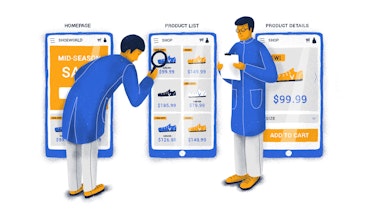Outstanding user experience is an invaluable asset for eCommerce growth. But because running a large online store is a strenuous task with many ins and outs, UX-oriented eCommerce design is often left out of the focus.
This business niche is saturated and many new stores are entering the market. Creating a frictionless marketplace will boost your growth and help with your differentiation.
Today, we’d like to look into a series of recommendations that can help businesses increase the quality of their user experience. By following these best practices, you’ll be able to both grow revenue and keep customers happy.
Let’s get to it!
1. Clear messaging and value proposition
A brand’s value proposition is as essential in UX as it is in marketing. It’s a promise that you make to your customers, and it has to be deeply rooted in your customer profile. It should aim to address the problems they want to solve.
Here are a few great examples:
Slack — Be More Productive at Work with Less Effort.
Dollar Shave Club — A top-shelf grooming routine. Personalized for you.
Warby Parker — Fashionable, Quality Glasses at an Affordable Price.
But how can you make sure that your eCommerce value proposition and overall messaging are on point?
First off, it’s clarity. Tell your potential customers what they should expect from your store. More importantly, your messaging should communicate the issues they’ll be able to solve.
Think of Etsy’s “Keep Commerce Human.” It’s a brilliant way to tell your customers that they value honest person-to-person interaction and handmade products. This way, it differentiates from the more commoditized and disposable things sold on Amazon.
Your site’s overall messaging should aim to be very clear about what it is you’re selling. Does your mobile eCom sell new or refurbished phones? Or is it more of a place that sells repair kits and cool accessories?
Recap: Clear messaging and a strong value proposition will signal to customers that they’ve reached the right place to address their needs.
2. Look into a unified search
Unfortunately, too many eCommerce sites disregard the importance of a well-executed search bar. You can occasionally see stores with poorly optimized search and others that chose to ditch it altogether.
According to a study published by Invesp, people very often like to plan out their purchases. Furthermore, they make less impulsive purchases than people generally expected. Therefore, it’s crucial to have a smooth search and navigation experience that helps people find what they need.
Here are a few excellent features you should consider adding to your search to improve navigation:
Fuzzy search
Simply put, this is an algorithm that makes search results less rigid. If your customer searched for “ssweaters”, your site will also return results for “sweater” and “sweaters”.
Smart autocomplete
Autocompleting your customers’ requests is a way of mediating between what they want and what the site can offer. This is an excellent way to decrease the time people spend searching for things. Similarly, this will minimize the chances of their search being unsuccessful.
Previewing results
As a way to further de-risk a user’s choice, the search bar should preview the products it’s suggesting. Adding product images and their categories should provide users with the necessary context. This will make their actions more efficient and satisfying.
Recap: By incorporating fuzzy search, smart autocomplete, and result previews, you can aid navigation and make users’ actions more efficient.
3. Take mental models into account
We’re all very different in how we understand the world we live in. This is why UX practices promote building products with mental models in mind (pun intended).
Mental models help us grasp our users’ motivations and the cognitive processes they use to operate in the world. This understanding helps us make predictions about them and their preferences. As a result, we can create experiences that are more intuitive to them.
Thoroughly research your users to better categorize your products. When conducting user research, make sure to include card-sorting exercises. They are very useful in defining the most suitable categories.
By creating more intuitive categories, you’ll be able to make the navigation smooth and efficient.
These steps will eventually increase discoverability, grow your conversions, and boost customer satisfaction.
But be very careful not to stray away from standards. Because we’ve used eCommerce systems for a long time, and we’ve formed expectations for how things work. Surprising users can create too much friction and hinder navigation.
Recap: When designing an e-commerce platform, tap into user research to understand your customers’ mental models. Use this information to categorize products and create intuitive categories. This will aid navigation and discoverability.
4. Guide users with suggestions
Providing users with meaningful suggestions is a win-win situation. First, it makes navigating a class of items much more straightforward.
If, for instance, your customer is on a sneaker page, recommending them other products in the same price range can offer valuable context. This context, as a result, reinforces their decision to purchase a specific product.
Similarly, very often, certain items make use of niche terminology. Think of bike parts, for instance. Many of us know very little about all the bits and pieces that go into a modern bicycle. Detailed and meaningful recommendations could help guide users by making complicated purchases.
There is a wide variety of Machine Learning-based recommender systems that can help here. Many of them have complex collaborative filtering functions. Such recommender systems can help you understand trends and make even better recommendations.
Recap: Suggestions and recommender systems help users make better choices with products they’re new to.
5. Invest in quality media
Images and videos of products are often the only way users can appreciate them. In a brick and mortar setting, they can engage with a variety of senses to understand whether a product suits them.
Research suggests that around 25% of eCommerce sites use images of unsatisfactory quality. As a result, they experience lower conversions and higher page abandonment.
In order to ensure excellent UX and customer satisfaction, businesses should invest more in quality media. This will decrease the number of returned products, as well as calibrate customer expectations.
Unfortunately, producers can’t always provide eCommerces with great pictures. However, this isn’t an excuse for stores to post pixellated images on their sites. On the contrary, this should be an invitation to take their own pictures.
But before you start snapping photos, think of where the emphasis should be? What do people look for in these products? What features should stand out?
Consider carefully observing how you and maybe other people look for or examine similar products in a brick and mortar setting. This can provide you with loads of insight into what parts of the product deserve extra attention.
Recap: High-quality media is essential for conversions. Consider investing in making your own photos if the ones offered by the producer aren’t good. Take this as an opportunity to emphasize the important aspects of a product.
6. Go beyond the checkout
Excellent CX doesn’t stop at the checkout button. There are a few small touches that can enhance a buyer’s experience.
Provide users with shipping costs and the delivery time as quickly as possible. This can help eliminate a great deal of anxiety associated with the purchase. That is especially relevant if users are ordering lager, hefty products.
Inform users about the availability of your products. It can be displayed as Available/Not Available, but showing the number of items left or stock percentage is also an option.
Recap: Informing users about product availability and shipping information will improve CX.
eCommerce Design: Conclusion
User experience doesn’t have an endpoint. A clear example of that is how well-executed eCommerce websites are today compared to 10 years ago. We’ve all gone a long way to improve buyers’ experiences, but we definitely have many new things to explore.
We hope you found these recommendations useful!




